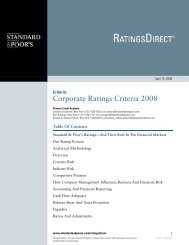European Infrastructure Finance Yearbook - Investing In Bonds ...
European Infrastructure Finance Yearbook - Investing In Bonds ...
European Infrastructure Finance Yearbook - Investing In Bonds ...
You also want an ePaper? Increase the reach of your titles
YUMPU automatically turns print PDFs into web optimized ePapers that Google loves.
TRANSPORTATION INFRASTRUCTURE<br />
60 ■ NOVEMBER 2007<br />
depreciation of remunerated assets, and<br />
required returns on the average value of<br />
remunerated assets.<br />
Although the CAA has demonstrated flexibility<br />
by allowing BAA to offset revenue losses caused<br />
by external events, such as the loss of duty free<br />
revenues in 1999, BAA does not benefit from<br />
regulatory protection in a situation of financial<br />
distress caused by financing decisions.<br />
Price control review: initial proposals.<br />
The formal process for setting the charges for Q5<br />
began in December 2005 when the CAA<br />
published its policy issues paper for consultation.<br />
BAA then rejected the CAA’s December 2006<br />
initial regulatory proposals as failing to<br />
incentivize the company to invest at its airports.<br />
The next stage in the process sees a review by the<br />
CC before the CAA sets prices in early 2008.<br />
The CAA has proposed that the allowed<br />
weighted average cost of capital (WACC) should<br />
be cut to 5.90%-6.20% for Heathrow and<br />
6.30%-6.70% for Gatwick, which would be a<br />
marked reduction from the 7.75% allowed in<br />
2003. This change could arguably prompt ADIL<br />
to lower its intended capital program. Such large<br />
movements between quinquennia may well result<br />
in rating volatility for BAA in the future.<br />
Significantly, the CAA has stated that it will not<br />
reconsider the level of WACC in view of the tax<br />
shield provided by the higher leverage ADIL<br />
intends to implement, or adopt a higher<br />
proportion of debt in the WACC calculation. This<br />
is a credit positive for BAA.<br />
The CAA has put forward indicative ranges for<br />
caps on airport charges at Heathrow of the retail<br />
price index (RPI) plus 4.0%-8.0%, compared<br />
with the current rate of growth in price-caps of<br />
RPI plus 6.5%. For Gatwick airport, the CAA has<br />
proposed a price-cap ranging from RPI minus 2%<br />
to RPI plus 2%, compared with the current rate<br />
of growth of RPI plus 0%. Standard & Poor’s<br />
does not consider that these changes will affect its<br />
analysis. Importantly, Heathrow will be<br />
authorized to continue implementing high fee<br />
increases. This is a credit strength, given that<br />
Heathrow remains the largest airport in the U.K.<br />
in terms of passengers, and given the significant<br />
capital expenditure plan underway.<br />
The price control proposals suggested by the<br />
CAA are now with the CC. Given the CC’s track<br />
record, we expect it to continue the supportive<br />
regulatory regime for investment that it delivered<br />
STANDARD & POOR’S EUROPEAN INFRASTRUCTURE FINANCE YEARBOOK<br />
in the fourth quinquennium.<br />
Finally, the CAA has recommended that the<br />
government should consider removing the<br />
requirement for the CAA to set price controls at<br />
Stansted, and instead dedesignate the airport. <strong>In</strong><br />
theory, BAA could therefore implement higher<br />
charges, but this may prove difficult considering<br />
the airport’s focus on low-cost carriers. This<br />
decision reflects the CAA’s acknowledgement that<br />
BAA currently charges below the regulator’s pricecap,<br />
and the view that Stansted does not have<br />
significant market power. The dedesignation is<br />
viewed as mildly positive overall, depending on<br />
the future competitive position of Stansted and<br />
how “stranded asset risk” is mitigated. We<br />
understand that ADIL continues to see Stansted<br />
airport as a core asset.<br />
The potential removal of Stansted from the<br />
regulated asset base (RAB) is unlikely to affect the<br />
proposed securitization of BAA, given that the<br />
airport only accounts for about 9% of the<br />
combined RAB of £11.3 billion (at March 2007).<br />
About £10.3 billion of regulated assets will<br />
remain to back the securitization financing, which<br />
should ensure that the transaction goes forward.<br />
Standard & Poor’s recognizes the importance of<br />
the method by which Stansted’s potential<br />
dedesignation will be accounted for within the<br />
ring-fence structure.<br />
Office of Fair Trading and Competition<br />
Commission investigation.<br />
The OFT launched an investigation into the U.K.<br />
airports sector in 2006. <strong>In</strong> December 2006, it<br />
reported its preliminary findings that BAA’s<br />
ownership of its airports, the system of economic<br />
regulation of airports in the U.K., and capacity<br />
constraints combine to prevent, restrict, or distort<br />
competition and referred the supply of airport<br />
services by BAA within the U.K. to the CC. This<br />
review is expected to take up to two years to<br />
complete. On Aug. 9, 2007, the CC released a<br />
statement of issues it would look at following the<br />
reference made to it by the OFT in March 2007.<br />
The CC declared it would now determine whether<br />
there are any features of the market that prevent,<br />
restrict, or distort competition, and, if so, what<br />
remedial action might be taken. The CC expects<br />
to publish for consultation in the early part of<br />
2008 a document setting its “emerging thinking”<br />
on all the key issues. It currently aims to publish<br />
its provisional findings around this time<br />
next year.



